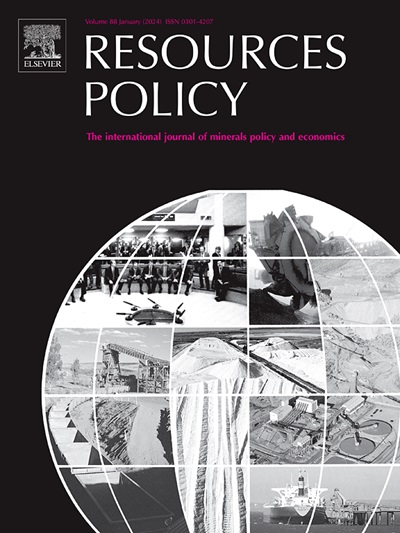Framework for assessing intranational risk of critical mineral sectors: Case study of India
IF 10.2
2区 经济学
0 ENVIRONMENTAL STUDIES
引用次数: 0
Abstract
Recent geopolitical actions regarding the supply of critical minerals have highlighted both the threats posed by countries dominating a critical mineral supply chain, and the potential mitigations served by alternative supplier countries. However, no systematic quantification exists for the intranational factors that determine such threats or mitigations. This study outlines a methodological framework for quantifying the intranational risk profile of critical mineral sectors and compares them with the sector's international potential for leverage. The four intranational factors of concentration, synchronization, private sector involvement, and regulatory obstacles were analyzed across multiple scales in order to determine an intranational risk score that quantifies the resilience or fragility of the critical mineral sector in question. Network analysis was also separately conducted to identify the most important entities operating across all critical mineral sectors. Finally, this study assessed the critical mineral sector's global share of reserves and production to determine an international risk score that quantifies the country's critical mineral sector's leverage potential. A case study of India showed that two critical mineral sectors with high leverage potential, chromite and barite, were respectively intranationally resilient and fragile. Of the remaining sectors with minimal leverage, five sectors such as aluminum were intranationally resilient and may serve as viable mitigation options for future critical mineral supply. Three sectors such as titanium were intranationally fragile, but recent regulatory developments may both decrease intranational risk and increase international risk, potentially making them major critical mineral sectors in the future.
评估关键矿产部门国内风险的框架:印度个案研究
最近在关键矿物供应方面采取的地缘政治行动既突出了主导关键矿物供应链的国家构成的威胁,也突出了替代供应国可能起到的缓解作用。然而,对于决定这些威胁或缓解措施的国家内部因素,没有系统的量化。本研究概述了一种方法框架,用于量化关键矿产部门的国内风险情况,并将其与该部门的国际杠杆潜力进行比较。在多个尺度上分析了集中、同步、私营部门参与和监管障碍这四个国内因素,以便确定一个国内风险评分,量化有关关键矿物部门的复原力或脆弱性。还分别进行了网络分析,以查明在所有关键矿物部门开展业务的最重要实体。最后,本研究评估了关键矿产部门在全球储量和产量中的份额,以确定量化该国关键矿产部门杠杆潜力的国际风险评分。印度的一个案例研究表明,具有高杠杆潜力的两个关键矿产部门,即铬铁矿和重晶石,在国内分别具有弹性和脆弱性。在其余杠杆率最低的部门中,铝等五个部门具有国内弹性,可作为未来关键矿物供应的可行缓解办法。钛等三个部门在国际上是脆弱的,但最近的管制发展可能既减少国际内风险又增加国际风险,可能使它们成为未来主要的关键矿物部门。
本文章由计算机程序翻译,如有差异,请以英文原文为准。
求助全文
约1分钟内获得全文
求助全文
来源期刊

Resources Policy
ENVIRONMENTAL STUDIES-
CiteScore
13.40
自引率
23.50%
发文量
602
审稿时长
69 days
期刊介绍:
Resources Policy is an international journal focused on the economics and policy aspects of mineral and fossil fuel extraction, production, and utilization. It targets individuals in academia, government, and industry. The journal seeks original research submissions analyzing public policy, economics, social science, geography, and finance in the fields of mining, non-fuel minerals, energy minerals, fossil fuels, and metals. Mineral economics topics covered include mineral market analysis, price analysis, project evaluation, mining and sustainable development, mineral resource rents, resource curse, mineral wealth and corruption, mineral taxation and regulation, strategic minerals and their supply, and the impact of mineral development on local communities and indigenous populations. The journal specifically excludes papers with agriculture, forestry, or fisheries as their primary focus.
 求助内容:
求助内容: 应助结果提醒方式:
应助结果提醒方式:


